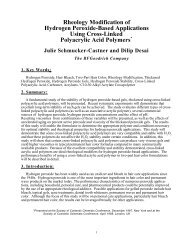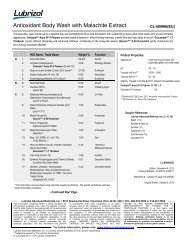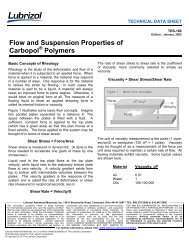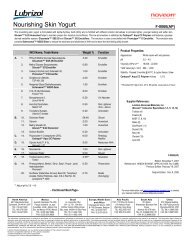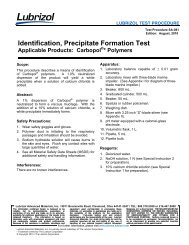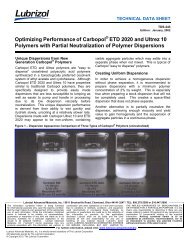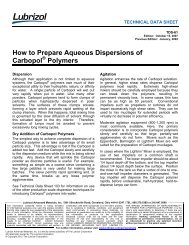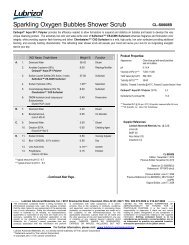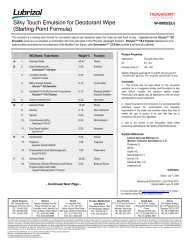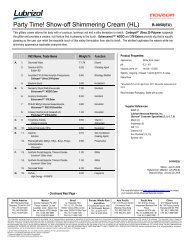TDS-222 Molecular Weight of Carbopol and Pemulen ... - Lubrizol
TDS-222 Molecular Weight of Carbopol and Pemulen ... - Lubrizol
TDS-222 Molecular Weight of Carbopol and Pemulen ... - Lubrizol
You also want an ePaper? Increase the reach of your titles
YUMPU automatically turns print PDFs into web optimized ePapers that Google loves.
TECHNICAL DATA SHEET<br />
<strong>TDS</strong>-<strong>222</strong><br />
Edition: July 10, 2008<br />
Previous Edition: January, 2002<br />
<strong>Molecular</strong> <strong>Weight</strong> <strong>of</strong> <strong>Carbopol</strong> ® * <strong>and</strong> <strong>Pemulen</strong>* Polymers<br />
Physical <strong>and</strong> Chemical Properties <strong>of</strong><br />
<strong>Carbopol</strong> ® <strong>and</strong> <strong>Pemulen</strong> Polymers<br />
<strong>Carbopol</strong> ® -type polymers, such as <strong>Carbopol</strong> ® ,<br />
<strong>Pemulen</strong> <strong>and</strong> Noveon ® , are polymers <strong>of</strong> acrylic<br />
acid, crosslinked with polyalkenyl ethers or divinyl<br />
glycol. <strong>Carbopol</strong> ® -type polymers are flocculated<br />
powders <strong>of</strong> particles averaging about 0.2 micron in<br />
diameter. The flocculated powders average 2 to 7<br />
microns as determined by Coulter Counter. These<br />
agglomerates cannot be broken down into the<br />
primary particle once produced.<br />
Each particle can be viewed as a network structure<br />
<strong>of</strong> polymer chains interconnected by crosslinks.<br />
Without the crosslinks, the primary particle would<br />
be a collection <strong>of</strong> linear polymer chains, intertwined<br />
but not chemically bonded. These linear polymers<br />
are soluble in a polar solvent, such as water.<br />
<strong>Carbopol</strong> ® 907 is a linear polymer <strong>and</strong> is soluble in<br />
water. All other <strong>Carbopol</strong> ® polymers, <strong>Pemulen</strong>,<br />
<strong>and</strong> Noveon ® polymers are crosslinked, <strong>and</strong> swell<br />
in water up to 1000 times their original volume (<strong>and</strong><br />
ten times their original diameter) to form a gel<br />
when exposed to a pH environment above 4-6.<br />
Since the pKa <strong>of</strong> these polymers is 6±0.5, the<br />
carboxylate groups on the polymer backbone<br />
ionize, resulting in repulsion between the negative<br />
particles, which adds to the swelling <strong>of</strong> the<br />
polymer. Crosslinked polymers do not dissolve in<br />
water.<br />
The glass transition temperature <strong>of</strong> <strong>Carbopol</strong> ® -type<br />
polymer is 105ºC in powder form. However, the<br />
glass transition temperature drops dramatically as<br />
the polymer comes into contact with water. The<br />
polymer chains start gyrating, <strong>and</strong> the radius <strong>of</strong><br />
gyration becomes bigger <strong>and</strong> bigger.<br />
Macroscopically, this phenomenon manifests itself<br />
as swelling.<br />
Defining <strong>Molecular</strong> <strong>Weight</strong> for a Polymer<br />
Polymers are heterogeneous mixtures <strong>of</strong> polymer<br />
homologues. When the molecular weight <strong>of</strong> a<br />
polymer is discussed, generally what is being<br />
referred to is actually the average molecular weight<br />
<strong>of</strong> these homologues. The molecular weight <strong>of</strong> a<br />
polymer is more fully characterized by number<br />
average molecular weight (Mn), weight average<br />
molecular weight (Mw), <strong>and</strong> viscosity molecular<br />
weight (Mv). The ratio <strong>of</strong> Mw to Mn characterizes<br />
the breadth <strong>of</strong> the molecular weight distribution,<br />
also known as "polydispersity." In order to fully<br />
characterize a polymer, both the average<br />
molecular weight, <strong>and</strong> the polydispersity must be<br />
defined.<br />
<strong>Molecular</strong> weights <strong>of</strong> crosslinked polymers are also<br />
characterized by the backbone chain length (i.e.<br />
molecular weight) between adjacent crosslinks,<br />
Mc. Each network structure, (a single particle) may<br />
be viewed as a single molecule. The mass <strong>of</strong> the<br />
particle is the molecular weight, assuming all<br />
polymer chains are inter-connected by chemical<br />
bonds or crosslinks.<br />
Measuring <strong>Molecular</strong> <strong>Weight</strong>s<br />
<strong>Molecular</strong> weights <strong>of</strong> linear polymers may be<br />
determined by appropriate physical measurements<br />
on very dilute solutions. Most commonly practiced<br />
methods are gel permeation chromatography<br />
(GPC) <strong>and</strong> intrinsic viscosity. Light scattering,<br />
ultracentrifugation, <strong>and</strong> osmometry are also used in<br />
the determination <strong>of</strong> molecular weight <strong>of</strong> polymers.<br />
However, all <strong>of</strong> these methods require the solubility<br />
<strong>of</strong> the polymer, <strong>and</strong> therefore cannot be used to<br />
determine the molecular weight <strong>of</strong> an insoluble,<br />
crosslinked polymer such as <strong>Carbopol</strong> ® .<br />
<strong>Lubrizol</strong> Advanced Materials, Inc. / 9911 Brecksville Road, Clevel<strong>and</strong>, Ohio 44141-3247 / TEL: 800.379.5389 or 216.447.5000<br />
The information contained herein is believed to be<br />
equipment used commercially in processing these<br />
Materials, Inc.’s direct control. THE SELLER MAKES NO<br />
reliable, but no representations, guarantees or<br />
materials, no warranties or guarantees are made as to<br />
WARRANTIES, EXPRESS OR IMPLIED, INCLUDING,<br />
warranties <strong>of</strong> any kind are made as to its accuracy,<br />
the suitability <strong>of</strong> the products for the application<br />
BUT NOT LIMITED TO, THE IMPLIED WARRANTIES<br />
suitability for particular applications or the results to be<br />
disclosed. Full-scale testing <strong>and</strong> end product<br />
OF MERCHANTABILITY AND FITNESS FOR A<br />
obtained therefrom.<br />
The information is based on<br />
performance are the responsibility <strong>of</strong> the user. <strong>Lubrizol</strong><br />
PARTICULAR PURPOSE. Nothing contained herein is<br />
laboratory work with small-scale equipment <strong>and</strong> does<br />
not necessarily indicate end product performance.<br />
Because <strong>of</strong> the variations in methods, conditions <strong>and</strong><br />
Advanced Materials, Inc. shall not be liable for <strong>and</strong> the<br />
customer assumes all risk <strong>and</strong> liability <strong>of</strong> any use <strong>of</strong><br />
h<strong>and</strong>ling <strong>of</strong> any material beyond <strong>Lubrizol</strong> Advanced<br />
to be considered as permission, recommendation, nor<br />
as an inducement to practice any patented invention<br />
without permission <strong>of</strong> the patent owner.<br />
For further information, please visit www.personalcare.noveon.com<br />
<strong>Lubrizol</strong> Advanced Materials, Inc. is a wholly owned subsidiary <strong>of</strong> The <strong>Lubrizol</strong> Corporation<br />
* Trademark owned by The <strong>Lubrizol</strong> Corporation<br />
© Copyright 2008 / The <strong>Lubrizol</strong> Corporation
2<br />
In addition, routine spectrophotometric analyses<br />
such as ultraviolet (UV), infrared (IR), or nuclear<br />
magnetic resonance spectroscopy (NMR), can<br />
provide information about functional groups in a<br />
polymer. NMR has been used in protein analysis<br />
to develop three dimensional structural information.<br />
This method relies on good chemical shift<br />
separation between proton resonances. The<br />
primary sequence <strong>of</strong> amino acids is known through<br />
sequencing, <strong>and</strong> nuclear overhauser effect (NOE)<br />
experiments are used to develop spatial<br />
information. These experiments, plus molecular<br />
modeling have allowed 3 dimensional protein<br />
structures to be determined. Unfortunately, in the<br />
case <strong>of</strong> acrylic acid polymers, good chemical shift<br />
separation does not occur, <strong>and</strong> this method cannot<br />
be used on <strong>Carbopol</strong> ® -type polymers.<br />
Measuring the <strong>Molecular</strong> <strong>Weight</strong>s <strong>of</strong><br />
Crosslinked Polymers<br />
The question <strong>of</strong> quantifying the molecular weights<br />
<strong>of</strong> <strong>Carbopol</strong> ® -type polymers is quite complex, <strong>and</strong><br />
there are no simple answers due to the r<strong>and</strong>om<br />
crosslinked network structure <strong>of</strong> the polymers.<br />
Unfortunately, whereas some naturally occurring<br />
polymers such as proteins have distinct primary,<br />
secondary, <strong>and</strong> tertiary structure, free radical<br />
polymers such as <strong>Carbopol</strong> ® -type polymers are<br />
r<strong>and</strong>om polymers. This in itself makes the<br />
polymers difficult to study because structural<br />
information is necessarily an average <strong>of</strong> many<br />
different molecules. In addition the simple fact that<br />
these polymers are crosslinked makes direct<br />
structural studies difficult. To date we have not<br />
been able to determine either the molecular weight<br />
<strong>of</strong> the polymer chains or the distance between<br />
crosslinks.<br />
Rheological Properties <strong>and</strong> <strong>Molecular</strong><br />
<strong>Weight</strong>s<br />
While the relationships between structure <strong>and</strong><br />
properties have been <strong>of</strong> interest both academically<br />
<strong>and</strong> in industry 1-6 few publications have attempted<br />
to characterize the structure-property relationships<br />
<strong>of</strong> <strong>Carbopol</strong> ® -type polymers. 7-11<br />
Different grades <strong>of</strong> <strong>Carbopol</strong> ® polymers exhibit<br />
different rheological properties, a reflection <strong>of</strong> the<br />
particle size, molecular weight between crosslinks<br />
(Mc), distributions <strong>of</strong> the Mc, <strong>and</strong> the fraction <strong>of</strong> the<br />
total units which occur as terminal units, i.e. free<br />
chain ends.<br />
The molecular weights between adjacent<br />
crosslinks (Mc) are approximately inversely<br />
proportional to the crosslinker density. These may<br />
be calculated from the functionality <strong>of</strong> the<br />
crosslinking monomer, the relative ratio <strong>of</strong> acrylic<br />
acid to crosslinking monomer, <strong>and</strong> the efficiency <strong>of</strong><br />
the crosslinking reaction, assuming negligible chain<br />
ends. 7 Alternatively, the molecular weight can be<br />
qualitatively compared to the rheological properties<br />
<strong>of</strong> a swollen gel <strong>and</strong>/or from the equilibrium<br />
swelling ratio. In simple terms, low viscosity, low<br />
rigidity polymer such as <strong>Carbopol</strong> ® 910, <strong>Carbopol</strong> ®<br />
941, <strong>and</strong> <strong>Carbopol</strong> ® 971P have a higher Mc, or<br />
conversely, have lower crosslinker densities. The<br />
higher the crosslinker level, the lower the<br />
equilibrium swelling ratio.<br />
In the network theory <strong>of</strong> elasticity, the elastic<br />
modulus, G, is inversely proportional to the<br />
molecular weight between crosslinks (Mc). There<br />
have been attempts to extend the elasticity theory<br />
to swollen gels. 7,8,10 Based on this approach,<br />
Taylor calculated an Mc for <strong>Carbopol</strong> ® 941 in the<br />
order <strong>of</strong> several million. This number is far too high<br />
as compared to the theoretical Mc calculated from<br />
the stoichiometry. Carnali <strong>and</strong> Naser estimated the<br />
Mc for <strong>Carbopol</strong> ® 941 to be 3,300 monomer units<br />
(or 3,300 x 72 = 237,600 gm/mole) derived from a<br />
combination <strong>of</strong> dilute solution viscosity <strong>and</strong><br />
equilibrium swelling. The Mc reported for<br />
<strong>Carbopol</strong> ® 940 was 1,450 monomer units (or<br />
1,450x72 = 104,400 gm/mole). 9<br />
What are the <strong>Molecular</strong> <strong>Weight</strong>s <strong>of</strong><br />
<strong>Carbopol</strong> ® <strong>and</strong> <strong>Pemulen</strong> Polymers?<br />
When <strong>Carbopol</strong> ® polymers have been polymerized<br />
under the same conditions, <strong>and</strong> using the same<br />
recipe as the crosslinked grades, but without the<br />
crosslinking monomer, the weight average<br />
molecular weights are in the order <strong>of</strong> about<br />
500,000 as measured by gel permeation<br />
chromatography using linear polyacrylic acid as<br />
reference.<br />
While the molecular weight <strong>of</strong> crosslinked<br />
<strong>Carbopol</strong> ® polymer between adjacent crosslinks,<br />
Mc, is in the order <strong>of</strong> thous<strong>and</strong>s, the actual<br />
molecular weight is in the billions. This is because<br />
each primary particle <strong>of</strong> crosslinked <strong>Carbopol</strong> ®<br />
polymer can be considered as a single gigantic<br />
molecule, with the crosslinks attaching to many<br />
linear chains together. The molecular weight <strong>of</strong><br />
such a molecule can be calculated from the size <strong>of</strong>
3<br />
the primary particle <strong>and</strong> the density <strong>of</strong> the polymer.<br />
The calculated molecular weight for a crosslinked<br />
<strong>Carbopol</strong> ® polymer with primary particle size <strong>of</strong> 0.2<br />
micron could be as high as 4.5 billion due to the<br />
interlinkage <strong>of</strong> many polymer chains.<br />
References:<br />
1. "Principles <strong>of</strong> Polymer Chemistry" by Paul J. Flory,<br />
Cornell University Press.<br />
2. "The Physics <strong>of</strong> Rubber Elasticity" by L.R.G.<br />
Treloar, Oxford University Press, New York, 1958.<br />
3. Advances in Polymer Science Vol. 109 & 110,<br />
Responsive Gels: I & II, Springer-Verlag.<br />
4. Peppas, N.A., "Characterization <strong>of</strong> Crosslinked<br />
Structure <strong>of</strong> Hydrogels", Hydrogels Med. Pharm. 1,<br />
27-56, 1986.<br />
5. Brannon-Peppas, L., "Preparation <strong>and</strong> Characterization<br />
<strong>of</strong> Crosslinked Hydrophilic Networks", Sud.<br />
Polym. Sci., 8, 45-66, 1990.<br />
6. Hooper, H.H. et al, "Swelling Equilibrium for<br />
Positively Ionized Poly(acrylamide) Hydrogels",<br />
Macromolecules, 23(4), 1096-1104, 1990.<br />
7. Taylor <strong>and</strong> Bagley, "Tailoring Closely Packed Gel-<br />
Particles Systems for Use as Thickening Agents", J.<br />
Appl. Polym. Sci., 21, pp. 113-122.<br />
8. Taylor <strong>and</strong> Bagley, "Rheology <strong>of</strong> Dispersions <strong>of</strong><br />
Swollen Gel Particles", J. Polym. Sci.: Polymer<br />
Physics Edition, Vol. 13, 1133-1144, 1975.<br />
9. Camali, J.O. <strong>and</strong> Naser, M.S., "The Use <strong>of</strong> Dilute<br />
Solution Viscosity to Characterize the Network<br />
Properties <strong>of</strong> <strong>Carbopol</strong> ® Microgels", Colloid &<br />
Polymer Science Vol. 270, No. 2, pp. 183-193,<br />
1992.<br />
10. Nae, H.N., <strong>and</strong> Reichert, W.W., "Rheological<br />
Properties <strong>of</strong> Lightly Crosslinked Carboxy Copolymers<br />
in Aqueous Solutions", Rheological Acta, Vol.<br />
31 (4), 351-360 (1992).<br />
11. Ishikawa, S., et al, "Evaluation <strong>of</strong> the Rheological<br />
Properties <strong>of</strong> Various Kinds <strong>of</strong> Carboxyvinylpolymer<br />
Gels", Chem. Pharm. Bull., 36(6), 2118-2127, 1988.




